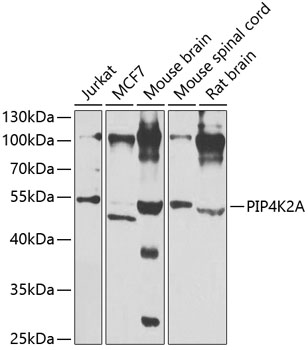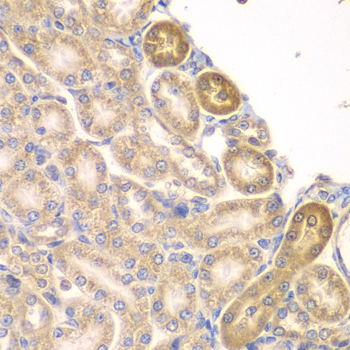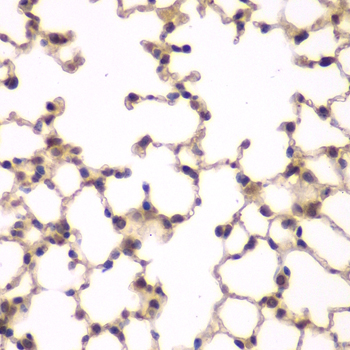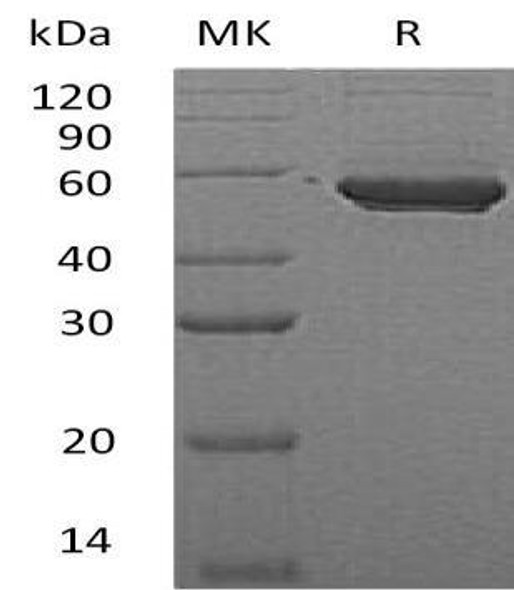Cell Biology Antibodies 11
Anti-PIP4K2A Antibody (CAB7446)
- SKU:
- CAB7446
- Product Type:
- Antibody
- Reactivity:
- Human
- Reactivity:
- Mouse
- Reactivity:
- Rat
- Host Species:
- Rabbit
- Isotype:
- IgG
- Antibody Type:
- Polyclonal Antibody
- Research Area:
- Cell Biology
Description
| Antibody Name: | Anti-PIP4K2A Antibody |
| Antibody SKU: | CAB7446 |
| Antibody Size: | 20uL, 50uL, 100uL |
| Application: | WB IHC IF |
| Reactivity: | Human, Mouse, Rat |
| Host Species: | Rabbit |
| Immunogen: | Recombinant fusion protein containing a sequence corresponding to amino acids 120-350 of human PIP4K2A (NP_005019.2). |
| Application: | WB IHC IF |
| Recommended Dilution: | WB 1:500 - 1:2000 IHC 1:50 - 1:200 IF 1:50 - 1:200 |
| Reactivity: | Human, Mouse, Rat |
| Positive Samples: | Jurkat, MCF7, Mouse brain, Mouse spinal cord, Rat brain |
| Immunogen: | Recombinant fusion protein containing a sequence corresponding to amino acids 120-350 of human PIP4K2A (NP_005019.2). |
| Purification Method: | Affinity purification |
| Storage Buffer: | Store at -20'C. Avoid freeze / thaw cycles. Buffer: PBS with 0.02% sodium azide, 50% glycerol, pH7.3. |
| Isotype: | IgG |
| Sequence: | APLP NDSQ ARSG ARFH TSYD KRYI IKTI TSED VAEM HNIL KKYH QYIV ECHG ITLL PQFL GMYR LNVD GVEI YVIV TRNV FSHR LSVY RKYD LKGS TVAR EASD KEKA KELP TLKD NDFI NEGQ KIYI DDNN KKVF LEKL KKDV EFLA QLKL MDYS LLVG IHDV ERAE QEEV ECEE NDGE EEGE SDGT HPVG TPPD SPGN TLNS SPPL APGE FDPN IDVY GIKC HENS PRK |
| Gene ID: | 5305 |
| Uniprot: | P48426 |
| Cellular Location: | Cell membrane, Cytoplasm, Nucleus |
| Calculated MW: | 39kDa/46kDa |
| Observed MW: | 46kDa |
| Synonyms: | PIP4K2A, PI5P4KA, PIP5K2A, PIP5KII-alpha, PIP5KIIA, PIPK |
| Background: | Phosphatidylinositol-5, 4-bisphosphate, the precursor to second messengers of the phosphoinositide signal transduction pathways, is thought to be involved in the regulation of secretion, cell proliferation, differentiation, and motility. The protein encoded by this gene is one of a family of enzymes capable of catalyzing the phosphorylation of phosphatidylinositol-5-phosphate on the fourth hydroxyl of the myo-inositol ring to form phosphatidylinositol-5, 4-bisphosphate. The amino acid sequence of this enzyme does not show homology to other kinases, but the recombinant protein does exhibit kinase activity. This gene is a member of the phosphatidylinositol-5-phosphate 4-kinase family. |
| UniProt Protein Function: | PIP4K2A: Catalyzes the phosphorylation of phosphatidylinositol 5- phosphate (PtdIns5P) on the fourth hydroxyl of the myo-inositol ring, to form phosphatidylinositol 4,5-bisphosphate (PtdIns(4,5)P2). May exert its function by regulating the levels of PtdIns5P, which functions in the cytosol by increasing AKT activity and in the nucleus signals through ING2. May regulate the pool of cytosolic PtdIns5P in response to the activation of tyrosine phosphorylation. May negatively regulate insulin- stimulated glucose uptake by lowering the levels of PtdIns5P. May be involved in thrombopoiesis, and the terminal maturation of megakaryocytes and regulation of their size. |
| UniProt Protein Details: | Protein type:Kinase, lipid; EC 2.7.1.149; Motility/polarity/chemotaxis; Carbohydrate Metabolism - inositol phosphate Chromosomal Location of Human Ortholog: 10p12.2 Cellular Component: plasma membrane; nucleus; cytosol Molecular Function:1-phosphatidylinositol-4-phosphate 5-kinase activity; 1-phosphatidylinositol-5-phosphate 4-kinase activity; ATP binding Biological Process: phosphoinositide phosphorylation; phospholipid metabolic process; phosphatidylinositol biosynthetic process |
| NCBI Summary: | Phosphatidylinositol-5,4-bisphosphate, the precursor to second messengers of the phosphoinositide signal transduction pathways, is thought to be involved in the regulation of secretion, cell proliferation, differentiation, and motility. The protein encoded by this gene is one of a family of enzymes capable of catalyzing the phosphorylation of phosphatidylinositol-5-phosphate on the fourth hydroxyl of the myo-inositol ring to form phosphatidylinositol-5,4-bisphosphate. The amino acid sequence of this enzyme does not show homology to other kinases, but the recombinant protein does exhibit kinase activity. This gene is a member of the phosphatidylinositol-5-phosphate 4-kinase family. [provided by RefSeq, Jul 2008] |
| UniProt Code: | P48426 |
| NCBI GenInfo Identifier: | 18266879 |
| NCBI Gene ID: | 5305 |
| NCBI Accession: | P48426.2 |
| UniProt Secondary Accession: | P48426,P53807, Q5VUX3, B0YJ66, B4DGX2, D3DRV1, |
| UniProt Related Accession: | P48426 |
| Molecular Weight: | 406 |
| NCBI Full Name: | Phosphatidylinositol 5-phosphate 4-kinase type-2 alpha |
| NCBI Synonym Full Names: | phosphatidylinositol-5-phosphate 4-kinase, type II, alpha |
| NCBI Official Symbol: | PIP4K2A |
| NCBI Official Synonym Symbols: | PIPK; PI5P4KA; PIP5K2A; PIP5KIIA; PIP5KII-alpha |
| NCBI Protein Information: | phosphatidylinositol 5-phosphate 4-kinase type-2 alpha; PIP5KIII; PIP5KIIalpha; PIP4KII-alpha; PI(5)P 4-kinase type II alpha; PtdIns(4)P-5-kinase B isoform; ptdIns(4)P-5-kinase C isoform; diphosphoinositide kinase 2-alpha; ptdIns(5)P-4-kinase isoform 2-alpha; 1-phosphatidylinositol-4-phosphate kinase; 1-phosphatidylinositol-4-phosphate-5-kinase; 1-phosphatidylinositol 5-phosphate 4-kinase 2-alpha; 1-phosphatidylinositol-5-phosphate 4-kinase 2-alpha; phosphatidylinositol-5-phosphate 4-kinase type-2 alpha; phosphatidylinositol 5-phosphate 4-kinase type II alpha; phosphatidylinositol-4-phosphate 5-kinase, type II, alpha; type II phosphatidylinositol-4-phosphate 5-kinase 53 K isoform |
| UniProt Protein Name: | Phosphatidylinositol 5-phosphate 4-kinase type-2 alpha |
| UniProt Synonym Protein Names: | 1-phosphatidylinositol 5-phosphate 4-kinase 2-alpha; Diphosphoinositide kinase 2-alpha; PIP5KIII; Phosphatidylinositol 5-phosphate 4-kinase type II alpha; PI(5)P 4-kinase type II alpha; PIP4KII-alpha; PtdIns(4)P-5-kinase B isoform; PtdIns(4)P-5-kinase C isoform; PtdIns(5)P-4-kinase isoform 2-alpha |
| Protein Family: | Phosphatidylinositol 5-phosphate 4-kinase |
| UniProt Gene Name: | PIP4K2A |
| UniProt Entry Name: | PI42A_HUMAN |
View AllClose










